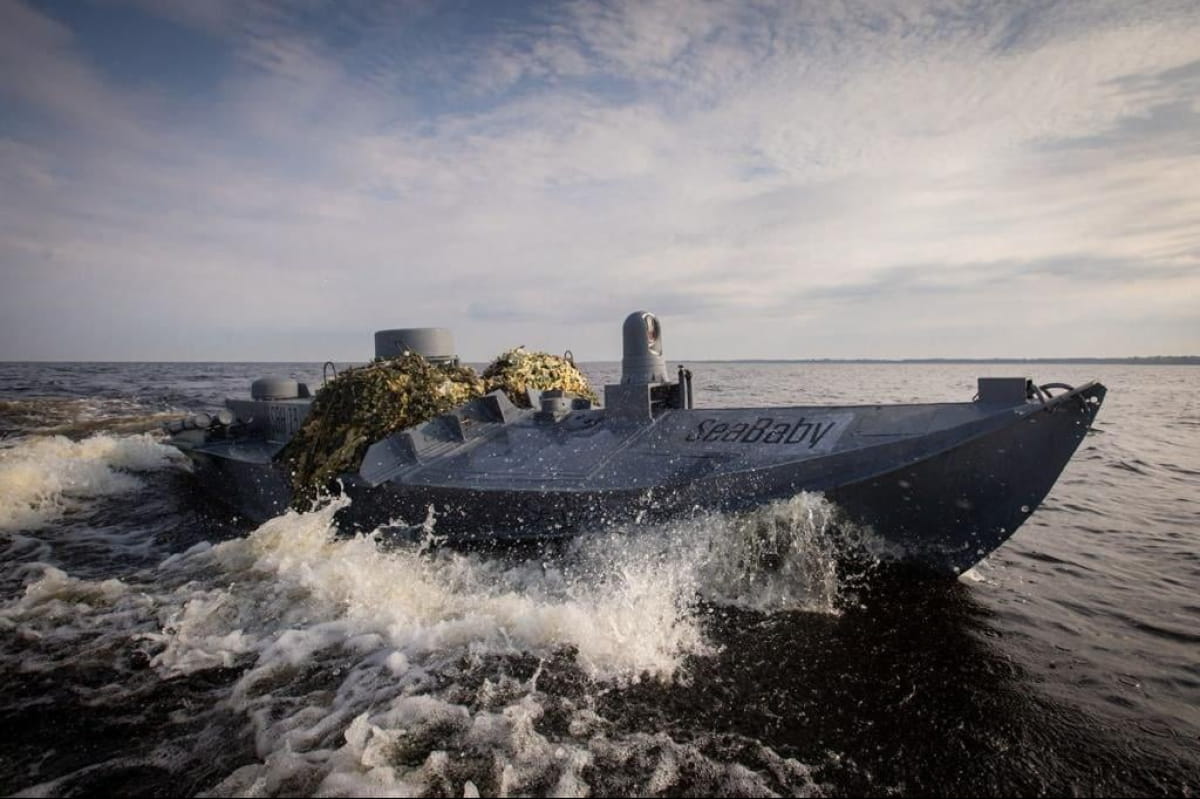
A ‘Sea Baby’ drone can be considered the first model of a naval drone with integrated weapons in the Defense Forces of Ukraine, which was developed by the Security Services of Ukraine. This drone is equipped with the capability to mount missile launchers, resembling the RPV-16 rocket-assisted thermobaric weapon, with a capacity ranging from two to six transport-launch containers situated at the rear of the platform.

The displacement of this drone varies from 1 to 5 tons, which should provide excellent performance in the coastal zone. In addition, such sizes will allow their deployment on the unprepared coast.
The specific use of these drones, whether as “kamikazes” or reusable platforms, remains undisclosed. However, experts speculate that equipped with rocket weapons, these drones can inflict substantial damage, serving both to distract the crew and facilitate direct detonation when deployed in naval operations.

The deployment of the Ukrainian ‘Sea Baby’ naval drone equipped with rocket weapons in December 2023 marked the first use of such a drone in targeting an enemy surface warship armed with integrated weaponry.
A video published by Ukrainska Pravda captures the salvo launch of missiles, the specific type of which remains unidentified, towards a surface target near Sevastopol Bay. The 16-second footage reveals the launch of 11 rockets targeting a Russian boat attempting interception.
This case demonstrates the swift advancement of unmanned surface systems, showcasing an augmentation in their firepower through the integration of novel missile weaponry.
Apart from grenade launchers, these platforms have the potential for outfitting guided missile weapons resembling anti-tank missile systems, along with grenade launchers and machine guns on remote weapon stations. Despite their evident advantages over conventional boats, naval drones still grapple with limitations tied to performance on the high seas.
Due to their compact dimensions and displacement, they exhibit a vulnerability to waves, leading to instances of capsizing due to platform load and suboptimal control.
To address this challenge and enhance performance and maneuverability in open waters, an improved platform design featuring increased displacement and reduced weaponry is essential. This would enhance stability in rough seas and employ a more strategic approach to maximize speed during sea waves, enabling them to catch up with other surface warships.

In addition, to increase firepower, naval drones can use laser-guided anti-tank missile systems as well as third-generation anti-tank systems, which do not require target designation for guidance, and the missile flight is carried out completely offline with programmed priority coordinates.
There is potential for the development of drones with a displacement of up to 100 tons, facilitating the use of fully-fledged anti-ship missiles characterized by relatively small dimensions and a low platform profile.
While the increased firepower poses a significant challenge for enemy naval surface forces, addressing the issue of installing an efficient power plant becomes crucial with heightened displacement. This consideration is essential to ensure both high speed and extended range for the naval drone.
Currently, the concept of developing surface drones with integrated weapons is still in its early stages, with a limited number of operational units. Ukraine’s use of naval drones has showcased the considerable potential for advancing these platforms.
The expertise gained by Ukraine in marine drone development has, in turn, contributed to the United States’ creation of a LRUSV (Large Unmanned Surface Vessel) — an unmanned boat with a small displacement, equipped with a module featuring Uvision Hero-120 loitering munitions.

The LRUSV is a semi-autonomous vessel capable of long-range operations. The LRUSV can also act as a carrier of strike kamikadze-drones, which are able to conduct reconnaissance of the area and hit targets at sea and land.
Hero-120 was selected in June 2021 for the OPF-M Corps competition to enhance the firepower of LRUSV boats, LAV-M self-propelled mortars, and JLTV tactical armored vehicles.
According to the manufacturer, the floundering drone can be in the air for an hour within a radius of 60 km. The drone is equipped with a 4.5 kg HEAT warhead.
The Hero-120 can also perform surveillance and reconnaissance functions and go back to the operator for reuse. This option should significantly expand the reconnaissance capabilities of the LRUSV.
Apart from the United States, China is actively engaged in the development of unmanned platforms with integrated weapons. This initiative aligns with China’s broader strategy to strengthen its navy to confront Taiwan.
The keen interest of leading nations in this field is expected to expedite research and development processes, fostering advancements in overall design. Additionally, it will drive the creation of efficient and low-noise power plants, as well as versatile launchers for various types of weaponry.
The general trend of the development of naval drones and the lack of a sufficient number of sailors who should form the basis of the crew of the warship will allow small countries to provide their fleet with a sufficient number of naval drones.
Over time, these drones will increase in size and become more powerful due to the installation of new weapons. This can lead to the creation of full-fledged unmanned missile boats with a displacement of up to 1000 tons.
Nevertheless, it is crucial to acknowledge that these systems will not be able to fully replace traditional boats and ships, which generally offer more functionality and capabilities in terms of target detection, escorting, and destruction using missile and artillery weapons.
Despite this, the very idea of unmanned platforms may interest many countries due to the lower price compared to full-fledged warships, the absence of crew, and mass production.
Підтримати нас можна через:
Приват: 5169 3351 0164 7408 PayPal - [email protected] Стати нашим патроном за лінком ⬇
Subscribe to our newsletter
or on ours Telegram
Thank you!!
You are subscribed to our newsletter